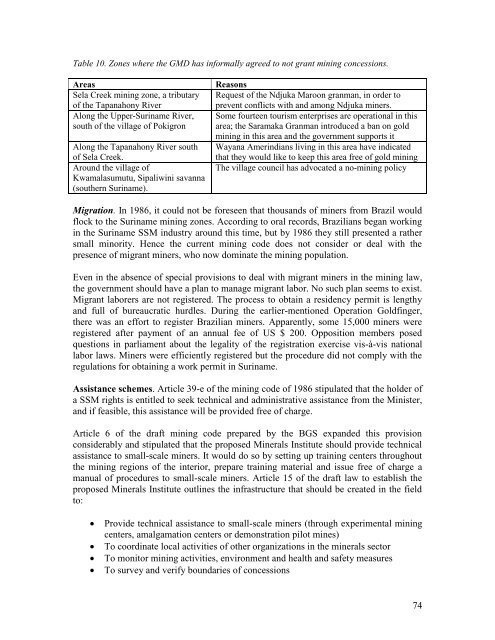SITUATION ANALYSIS OF THE SMALL-SCALE GOLD ... - WWF
SITUATION ANALYSIS OF THE SMALL-SCALE GOLD ... - WWF
SITUATION ANALYSIS OF THE SMALL-SCALE GOLD ... - WWF
Create successful ePaper yourself
Turn your PDF publications into a flip-book with our unique Google optimized e-Paper software.
Table 10. Zones where the GMD has informally agreed to not grant mining concessions.<br />
Areas Reasons<br />
Sela Creek mining zone, a tributary Request of the Ndjuka Maroon granman, in order to<br />
of the Tapanahony River<br />
prevent conflicts with and among Ndjuka miners.<br />
Along the Upper-Suriname River, Some fourteen tourism enterprises are operational in this<br />
south of the village of Pokigron area; the Saramaka Granman introduced a ban on gold<br />
mining in this area and the government supports it<br />
Along the Tapanahony River south Wayana Amerindians living in this area have indicated<br />
of Sela Creek.<br />
that they would like to keep this area free of gold mining<br />
Around the village of<br />
Kwamalasumutu, Sipaliwini savanna<br />
(southern Suriname).<br />
The village council has advocated a no-mining policy<br />
Migration. In 1986, it could not be foreseen that thousands of miners from Brazil would<br />
flock to the Suriname mining zones. According to oral records, Brazilians began working<br />
in the Suriname SSM industry around this time, but by 1986 they still presented a rather<br />
small minority. Hence the current mining code does not consider or deal with the<br />
presence of migrant miners, who now dominate the mining population.<br />
Even in the absence of special provisions to deal with migrant miners in the mining law,<br />
the government should have a plan to manage migrant labor. No such plan seems to exist.<br />
Migrant laborers are not registered. The process to obtain a residency permit is lengthy<br />
and full of bureaucratic hurdles. During the earlier-mentioned Operation Goldfinger,<br />
there was an effort to register Brazilian miners. Apparently, some 15,000 miners were<br />
registered after payment of an annual fee of US $ 200. Opposition members posed<br />
questions in parliament about the legality of the registration exercise vis-à-vis national<br />
labor laws. Miners were efficiently registered but the procedure did not comply with the<br />
regulations for obtaining a work permit in Suriname.<br />
Assistance schemes. Article 39-e of the mining code of 1986 stipulated that the holder of<br />
a SSM rights is entitled to seek technical and administrative assistance from the Minister,<br />
and if feasible, this assistance will be provided free of charge.<br />
Article 6 of the draft mining code prepared by the BGS expanded this provision<br />
considerably and stipulated that the proposed Minerals Institute should provide technical<br />
assistance to small-scale miners. It would do so by setting up training centers throughout<br />
the mining regions of the interior, prepare training material and issue free of charge a<br />
manual of procedures to small-scale miners. Article 15 of the draft law to establish the<br />
proposed Minerals Institute outlines the infrastructure that should be created in the field<br />
to:<br />
Provide technical assistance to small-scale miners (through experimental mining<br />
centers, amalgamation centers or demonstration pilot mines)<br />
To coordinate local activities of other organizations in the minerals sector<br />
To monitor mining activities, environment and health and safety measures<br />
To survey and verify boundaries of concessions<br />
74
















